[English] 日本語
 Yorodumi
Yorodumi- EMDB-3239: Cryo-EM structure of gamma secretase in class 2 of the apo-state ... -
+ Open data
Open data
- Basic information
Basic information
| Entry | Database: EMDB / ID: EMD-3239 | |||||||||
|---|---|---|---|---|---|---|---|---|---|---|
| Title | Cryo-EM structure of gamma secretase in class 2 of the apo-state ensemble | |||||||||
 Map data Map data | Reconstruction of gamma secretase in class 2 of the apo-state ensemble | |||||||||
 Sample Sample |
| |||||||||
| Function / homology |  Function and homology information Function and homology informationCajal-Retzius cell differentiation / positive regulation of L-glutamate import across plasma membrane / amyloid precursor protein biosynthetic process / negative regulation of core promoter binding / positive regulation of endopeptidase activity / gamma-secretase complex / short-term synaptic potentiation / aspartic endopeptidase activity, intramembrane cleaving / positive regulation of amyloid precursor protein biosynthetic process / smooth endoplasmic reticulum calcium ion homeostasis ...Cajal-Retzius cell differentiation / positive regulation of L-glutamate import across plasma membrane / amyloid precursor protein biosynthetic process / negative regulation of core promoter binding / positive regulation of endopeptidase activity / gamma-secretase complex / short-term synaptic potentiation / aspartic endopeptidase activity, intramembrane cleaving / positive regulation of amyloid precursor protein biosynthetic process / smooth endoplasmic reticulum calcium ion homeostasis / Noncanonical activation of NOTCH3 / protein catabolic process at postsynapse / TGFBR3 PTM regulation / sequestering of calcium ion / Notch receptor processing / synaptic vesicle targeting / positive regulation of coagulation / central nervous system myelination / negative regulation of axonogenesis / membrane protein intracellular domain proteolysis / skin morphogenesis / choline transport / T cell activation involved in immune response / NOTCH4 Activation and Transmission of Signal to the Nucleus / dorsal/ventral neural tube patterning / ciliary rootlet / neural retina development / regulation of resting membrane potential / L-glutamate import across plasma membrane / Regulated proteolysis of p75NTR / myeloid dendritic cell differentiation / regulation of phosphorylation / metanephros development / endoplasmic reticulum calcium ion homeostasis / brain morphogenesis / amyloid precursor protein metabolic process / regulation of synaptic vesicle cycle / locomotion / regulation of long-term synaptic potentiation / regulation of postsynapse organization / astrocyte activation involved in immune response / embryonic limb morphogenesis / cell fate specification / regulation of canonical Wnt signaling pathway / myeloid cell homeostasis / aggresome / growth factor receptor binding / skeletal system morphogenesis / Hydrolases; Acting on peptide bonds (peptidases); Aspartic endopeptidases / Golgi cisterna membrane / azurophil granule membrane / positive regulation of amyloid fibril formation / glutamate receptor signaling pathway / G protein-coupled dopamine receptor signaling pathway / : / blood vessel development / amyloid-beta formation / mitochondrial transport / amyloid precursor protein catabolic process / heart looping / regulation of neuron projection development / positive regulation of dendritic spine development / adult behavior / cerebral cortex cell migration / smooth endoplasmic reticulum / positive regulation of receptor recycling / membrane protein ectodomain proteolysis / nuclear outer membrane / negative regulation of apoptotic signaling pathway / EPH-ephrin mediated repulsion of cells / autophagosome assembly / negative regulation of ubiquitin-dependent protein catabolic process / endopeptidase activator activity / somitogenesis / neuron development / hematopoietic progenitor cell differentiation / T cell proliferation / regulation of synaptic transmission, glutamatergic / Nuclear signaling by ERBB4 / calcium ion homeostasis / Degradation of the extracellular matrix / Notch signaling pathway / rough endoplasmic reticulum / neuron projection maintenance / astrocyte activation / NOTCH2 Activation and Transmission of Signal to the Nucleus / cellular response to calcium ion / NRIF signals cell death from the nucleus / thymus development / cerebellum development / positive regulation of glycolytic process / Activated NOTCH1 Transmits Signal to the Nucleus / dendritic shaft / epithelial cell proliferation / post-embryonic development / PDZ domain binding / neuromuscular junction / NOTCH3 Activation and Transmission of Signal to the Nucleus / apoptotic signaling pathway / cell-cell adhesion Similarity search - Function | |||||||||
| Biological species |  Homo sapiens (human) Homo sapiens (human) | |||||||||
| Method | single particle reconstruction / cryo EM / negative staining / Resolution: 4.0 Å | |||||||||
 Authors Authors | Bai XC / Rajendra E / Yang GH / Shi YG / Scheres SHW | |||||||||
 Citation Citation |  Journal: Elife / Year: 2015 Journal: Elife / Year: 2015Title: Sampling the conformational space of the catalytic subunit of human γ-secretase. Authors: Xiao-chen Bai / Eeson Rajendra / Guanghui Yang / Yigong Shi / Sjors H W Scheres /   Abstract: Human γ-secretase is an intra-membrane protease that cleaves many different substrates. Aberrant cleavage of Notch is implicated in cancer, while abnormalities in cutting amyloid precursor protein ...Human γ-secretase is an intra-membrane protease that cleaves many different substrates. Aberrant cleavage of Notch is implicated in cancer, while abnormalities in cutting amyloid precursor protein lead to Alzheimer's disease. Our previous cryo-EM structure of γ-secretase revealed considerable disorder in its catalytic subunit presenilin. Here, we describe an image classification procedure that characterizes molecular plasticity at the secondary structure level, and apply this method to identify three distinct conformations in our previous sample. In one of these conformations, an additional transmembrane helix is visible that cannot be attributed to the known components of γ-secretase. In addition, we present a γ-secretase structure in complex with the dipeptidic inhibitor N-[N-(3,5-difluorophenacetyl)-L-alanyl]-S-phenylglycine t-butyl ester (DAPT). Our results reveal how conformational mobility in the second and sixth transmembrane helices of presenilin is greatly reduced upon binding of DAPT or the additional helix, and form the basis for a new model of how substrate enters the transmembrane domain. | |||||||||
| History |
|
- Structure visualization
Structure visualization
| Movie |
 Movie viewer Movie viewer |
|---|---|
| Structure viewer | EM map:  SurfView SurfView Molmil Molmil Jmol/JSmol Jmol/JSmol |
| Supplemental images |
- Downloads & links
Downloads & links
-EMDB archive
| Map data |  emd_3239.map.gz emd_3239.map.gz | 20.7 MB |  EMDB map data format EMDB map data format | |
|---|---|---|---|---|
| Header (meta data) |  emd-3239-v30.xml emd-3239-v30.xml emd-3239.xml emd-3239.xml | 10.1 KB 10.1 KB | Display Display |  EMDB header EMDB header |
| Images |  EMD-3239.jpg EMD-3239.jpg | 223.1 KB | ||
| Archive directory |  http://ftp.pdbj.org/pub/emdb/structures/EMD-3239 http://ftp.pdbj.org/pub/emdb/structures/EMD-3239 ftp://ftp.pdbj.org/pub/emdb/structures/EMD-3239 ftp://ftp.pdbj.org/pub/emdb/structures/EMD-3239 | HTTPS FTP |
-Related structure data
| Related structure data |  5fn4MC  3237C  3238C  3240C  5fn2C  5fn3C  5fn5C M: atomic model generated by this map C: citing same article ( |
|---|---|
| Similar structure data |
- Links
Links
| EMDB pages |  EMDB (EBI/PDBe) / EMDB (EBI/PDBe) /  EMDataResource EMDataResource |
|---|---|
| Related items in Molecule of the Month |
- Map
Map
| File |  Download / File: emd_3239.map.gz / Format: CCP4 / Size: 21.7 MB / Type: IMAGE STORED AS FLOATING POINT NUMBER (4 BYTES) Download / File: emd_3239.map.gz / Format: CCP4 / Size: 21.7 MB / Type: IMAGE STORED AS FLOATING POINT NUMBER (4 BYTES) | ||||||||||||||||||||||||||||||||||||||||||||||||||||||||||||||||||||
|---|---|---|---|---|---|---|---|---|---|---|---|---|---|---|---|---|---|---|---|---|---|---|---|---|---|---|---|---|---|---|---|---|---|---|---|---|---|---|---|---|---|---|---|---|---|---|---|---|---|---|---|---|---|---|---|---|---|---|---|---|---|---|---|---|---|---|---|---|---|
| Annotation | Reconstruction of gamma secretase in class 2 of the apo-state ensemble | ||||||||||||||||||||||||||||||||||||||||||||||||||||||||||||||||||||
| Projections & slices | Image control
Images are generated by Spider. | ||||||||||||||||||||||||||||||||||||||||||||||||||||||||||||||||||||
| Voxel size | X=Y=Z: 1.4 Å | ||||||||||||||||||||||||||||||||||||||||||||||||||||||||||||||||||||
| Density |
| ||||||||||||||||||||||||||||||||||||||||||||||||||||||||||||||||||||
| Symmetry | Space group: 1 | ||||||||||||||||||||||||||||||||||||||||||||||||||||||||||||||||||||
| Details | EMDB XML:
CCP4 map header:
| ||||||||||||||||||||||||||||||||||||||||||||||||||||||||||||||||||||
-Supplemental data
- Sample components
Sample components
-Entire : human gamma secretase in class 2 of the apo-state ensemble
| Entire | Name: human gamma secretase in class 2 of the apo-state ensemble |
|---|---|
| Components |
|
-Supramolecule #1000: human gamma secretase in class 2 of the apo-state ensemble
| Supramolecule | Name: human gamma secretase in class 2 of the apo-state ensemble type: sample / ID: 1000 / Oligomeric state: Heterotetramer / Number unique components: 1 |
|---|---|
| Molecular weight | Experimental: 170 KDa / Theoretical: 170 KDa |
-Macromolecule #1: gamma-secretase
| Macromolecule | Name: gamma-secretase / type: protein_or_peptide / ID: 1 / Number of copies: 1 / Oligomeric state: Heterotetramer / Recombinant expression: Yes |
|---|---|
| Source (natural) | Organism:  Homo sapiens (human) / synonym: Human / Cell: HEK293F / Location in cell: membrane Homo sapiens (human) / synonym: Human / Cell: HEK293F / Location in cell: membrane |
| Molecular weight | Experimental: 170 KDa / Theoretical: 170 KDa |
| Recombinant expression | Organism:  Homo sapiens (human) / Recombinant cell: HEK 293F / Recombinant plasmid: pMLink Homo sapiens (human) / Recombinant cell: HEK 293F / Recombinant plasmid: pMLink |
-Experimental details
-Structure determination
| Method | negative staining, cryo EM |
|---|---|
 Processing Processing | single particle reconstruction |
| Aggregation state | particle |
- Sample preparation
Sample preparation
| Concentration | 6 mg/mL |
|---|---|
| Buffer | pH: 7.4 Details: 25 mM HEPES, pH 7.4, 150 mM NaCl and amphipol A8-35 |
| Staining | Type: NEGATIVE / Details: cryo-EM |
| Grid | Details: 300 mesh Au 1.2/1.3 Quantifoil grid, glow discharged for 1 minute |
| Vitrification | Cryogen name: ETHANE / Chamber humidity: 100 % / Chamber temperature: 85 K / Instrument: FEI VITROBOT MARK IV / Method: Blot for 4 seconds before plunging |
- Electron microscopy
Electron microscopy
| Microscope | FEI TITAN KRIOS |
|---|---|
| Temperature | Min: 80 K / Max: 90 K / Average: 85 K |
| Alignment procedure | Legacy - Astigmatism: Objective lens astigmatism was corrected at 81000 magnification |
| Specialist optics | Energy filter - Name: Gatan Quantum / Energy filter - Lower energy threshold: 0.0 eV / Energy filter - Upper energy threshold: 20.0 eV |
| Date | Oct 25, 2014 |
| Image recording | Category: CCD / Film or detector model: GATAN K2 QUANTUM (4k x 4k) / Digitization - Sampling interval: 5 µm / Number real images: 2925 / Average electron dose: 38 e/Å2 Details: Use a newly developed statistical movie processing and particle polishing approach to compensate for beam-induced movement and reduce the effect of radiation-damage |
| Electron beam | Acceleration voltage: 300 kV / Electron source:  FIELD EMISSION GUN FIELD EMISSION GUN |
| Electron optics | Calibrated magnification: 35714 / Illumination mode: FLOOD BEAM / Imaging mode: BRIGHT FIELD / Cs: 2.7 mm / Nominal defocus max: 3.2 µm / Nominal defocus min: 0.7 µm / Nominal magnification: 81000 |
| Sample stage | Specimen holder model: FEI TITAN KRIOS AUTOGRID HOLDER |
| Experimental equipment |  Model: Titan Krios / Image courtesy: FEI Company |
- Image processing
Image processing
| CTF correction | Details: Each particle |
|---|---|
| Final reconstruction | Applied symmetry - Point group: C1 (asymmetric) / Resolution.type: BY AUTHOR / Resolution: 4.0 Å / Resolution method: OTHER / Software - Name: CTFFIND4, RELION / Number images used: 79263 |
 Movie
Movie Controller
Controller


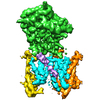



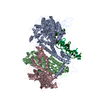


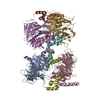
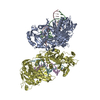











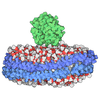

 Z (Sec.)
Z (Sec.) Y (Row.)
Y (Row.) X (Col.)
X (Col.)





















